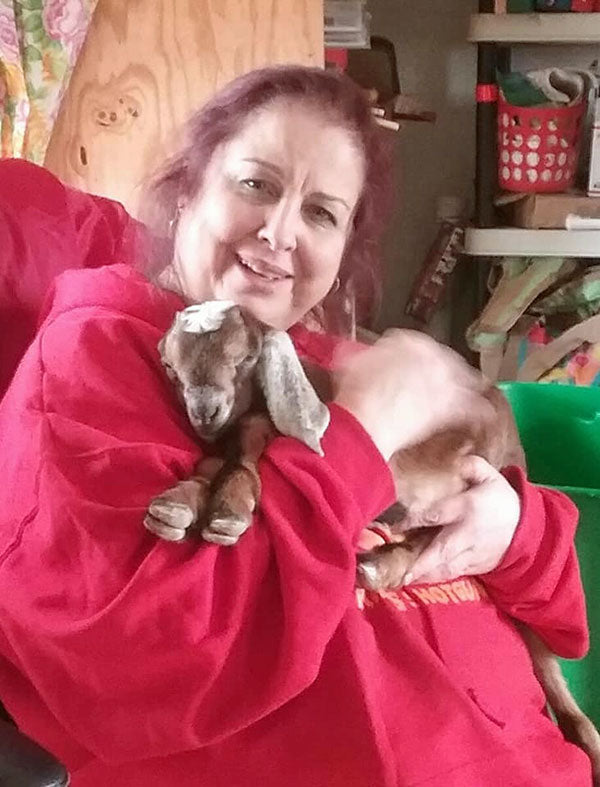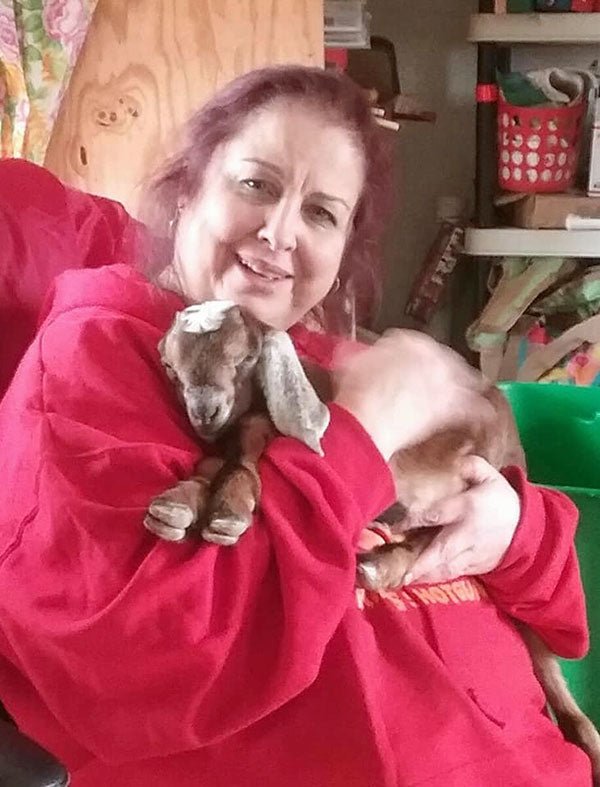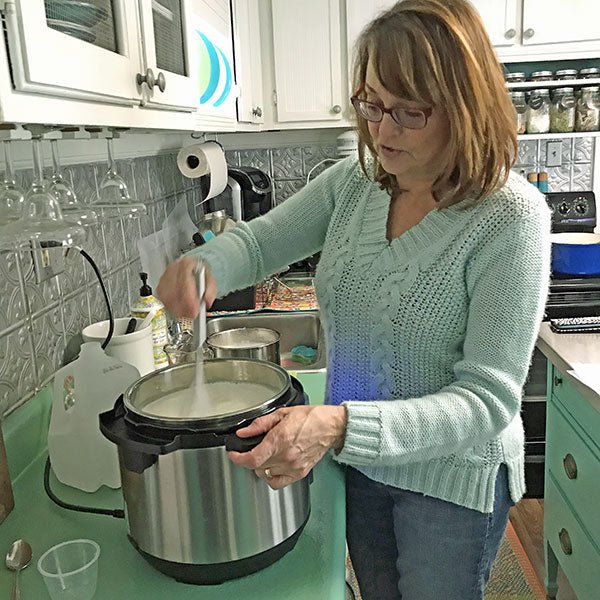
I am a pediatrician in a small mountain town in Arizona (Show Low). I got into goats a couple of years ago, but really started learning things from my friend Wendy (a science teacher PhD) and her daughter Hazel (they run Witch Hazel Dairy).

F’nor, on his spool, ‘goat-kissing’ Hazel at Witch Hazel Dairy
Currently I have 10 goats, 2 girls in milk (Whimsy is a LaMancha and Star is a Nubian). I’m looking forward to breeding my experimental Nubian/Mancha girls next year to see if they have the higher fat content milk with the volume that the Mancha makes.





I started learning to make cheese from a 1 hr cheese book, but then, in my normal fashion, became somewhat obsessed.

Since we are limited with room and the number of people who actually eat the cheese (my son said that it’s hard being lactose intolerant on a dairy), we found a way to store the feta long term with olive oil and herbs. I mostly give it away as Arizona is a state where it’s hard to sell if you are not an official dairy.



We also make soap from goat’s milk which it amazing.


I sell some at the little “store front” at my office, but mostly just give it away to friends and family. I have also tried at the occasional farmer’s market when I can, an Etsy site and a Facebook page (https://www.facebook.com/Itsthegoatsfault/) with my friend Wendy.

I keep busy (as if that weren’t enough) with crocheting and playing with dragons.

Currently, I am seeing patients all day and then have rehearsal a couple of days a week for a show I am in with the local college theater company. And I really just love the theater and acting. Getting involved in the college was the only was to pursue that passion, but one day I’d love to open my own theater.

How did you get started raising goats and making cheese?
When we moved to Arizona from New Jersey, I wanted some chickens, so I started there.

Eggs from chickens and turkeys (the large speckled ones on the right)
I thought goats would be good for milk but had no clue what I was doing. I started with a small Alpine (I think) and her son and then added a Pygmy and her two daughters. I went away for some personal reasons and my adult children bought a Toggenburg buck that proceeded to get everyone pregnant. I ended up with baby goats and milking moms in January and no clue what to do with either. Fortunately, Wendy and Hazel came into my life and taught me much about what I was doing wrong and how to fix it.
We ended up getting rid of that herd and starting over with registered healthy goats. Whimsy is a LaMancha and Star and Astra are Nubians. We had babies in the early summer from Whimsy bred to a Nubian and Star bred to the same buck, giving us 5 new babies. Doby, Luna and Bellatrix are experimental Mancha/Nubians and Snow and Stormy are Nubians.

Whimsey

The babies – Stormy, Luna and Bellatrix
As for milking, due to my busy life as a pediatrician, I opted to do a combination of bottle and dam feeding. My girls were very cooperative with their birthing and waited until I got home from work or the weekend. After the first few days, I was able to leave the babies with the moms during the day and then separate them out at night. This way I could bottle feed from a fresh milking first thing in the morning (Whimsy, the LaMancha made enough for all the babies) and still have some for our use.
Then, the babies would nurse all day from their moms and be separated at night. This meant that I didn’t get much milk at night until I started weaning, but Whimsy’s babies are still nursing during the day at 9 months old. Recently I switched to a once a day nursing of both girls as Star was showing signs of milk fever. Apparently she puts all of her calories into milk and not enough into her. She still produces over 4 lbs (1/2 gallon) every morning. So to answer your question, I am still milking 2 does every morning before work.
I strain the milk through the filter paper and then immediately cool it in an ice/salt water bath in the freezer.


Cooling in the freezer

Fridge full of milk
This cools it quickly to Grade A quality. Unfortunately, there are times when I forget it in the freezer and head off to work – finding it frozen when I get home. So far, the 1/2 gallon mason jars have survived the process.
As for cheese making, my only goal currently is just to use up the plethora of milk that I get on a weekly basis. Due to my busy schedule pursuing all of my passions, I usually stick with cheeses that are the least labor intensive. The soft cheeses that I can make with the individual packets that I’ve bought from your store are easy and tasty, but I usually have to freeze them because we just can’t eat that much (we are all lactose intolerant). Fortunately they freeze well, but there is only so much room in the freezer.
The feta is easy, and other than about a 3 hr time commitment before hanging, it is rather labor un-intensive. I use a recipe from Goats Produce Too! The Udder Real Thing Volume II by Mary Jane Toth. I hope to sell it at a farmer’s market someday, but here it can only be sold as “pet food” unless you are an official dairy.

Feta draining



Feta salted

Whey has come off the feta after it was salted and aged for 24 hrs at room temperature.

Sliced and salted
I grow fresh herbs in aerogardens that I dry for use in the cheese.

Lavendar

Basil

Asian herb varieties with more basil

Adding dried herbs and oil to the feta

Making ricotta:
I have been recovering whey from my goat milk for a while. I make a lot of feta with it, as I can store it in jars with oil and Italian herbs. After I drain the feta, the whey leftover gets put back in the cheese pot to boil (I do occasionally forget and it boils over…). I don’t add anything additional as the cheese culture and rennet that is already in there seems to do the trick. I also leave it to cool overnight and it separates very nicely.





I then strain it through the flour towels (which I use for all of my cheese now). Sometimes I need to hang it and sometimes it drains fast just using a colander. The remainder then goes out to the animals.




Clear yellow whey after the ricotta drains
I use the ricotta in bread recipes (Italian cheese bread in the bread maker is wonderful, but I am not good at exact measurements). I have also used it in cheese cake, omelettes, a really great stuffed chicken breast and I have mixed it with some sour cream, cheddar cheese and peppers for a really great dip.
I was doing some pressed cheeses, but it is an all day affair, so it requires a weekend where nothing else is planned, and then they must age and get waxed, which is another big project.

Presses

Cave

















































































































































